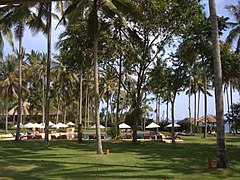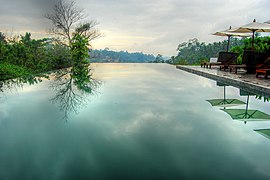Equatorial Ostiecia: Difference between revisions
Tags: Mobile edit Mobile web edit Advanced mobile edit |
mNo edit summary Tags: Mobile edit Mobile web edit Advanced mobile edit |
||
| Line 511: | Line 511: | ||
<gallery mode="packed"> | <gallery mode="packed"> | ||
File:Bali Urwald SvG.jpg | File:Bali Urwald SvG.jpg | ||
File:-bali resort (6288104931).jpg | |||
File:Alila Manggis hotel (swimming pool) - panoramio.jpg | |||
File:Alila Infinity Pool (HDR) (1365818884).jpg | |||
</gallery> | </gallery> | ||
====Agrinergie==== | ====Agrinergie==== | ||
Revision as of 14:35, 23 March 2024
This article is a work-in-progress because it is incomplete and pending further input from an author. Note: The contents of this article are not considered canonical and may be inaccurate. Please comment on this article's talk page to share your input, comments and questions. |
Script error: The module returned a nil value. It is supposed to return an export table.
Equatorial Ostiecia
Burgoignesc Equatorial Ostiecia | |
|---|---|
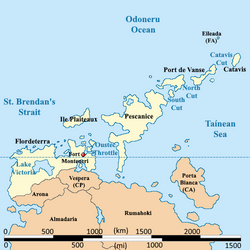 Provinces of Equatorial Ostiecia | |
| Nation | |
| Constituent Country | |
| Capital | Fort Monteneri |
| Government | |
| • Prince(ss)-President | Amethine-Ophelia IV |
| • Prime Minister | Pau-Evisan Estienne de Viersir |
| Area | |
| • Total | 460,862.482 km2 (177,939.999 sq mi) |
| Population (2030) | |
| • Total | 58,755,287 |
| • Density | 130/km2 (330/sq mi) |
| Demonym | Equitorioise |
Equatorial Ostiecia is a large constituent country of Burgundie located on the northern end of Vallos, at the confluences of the Odoneru Ocean, St. Brendan's Strait, the Taínean Sea, and the Polynesian Sea. It is bordered but Vespera, a province of Caphiria in the southeast, Arona a province of Urcea in the southwest, and shares a maritime border with Eilada an island province of Faneria in the northeast. Its province of Flordeterra is in the Vallosian region of Nordercia and it's island provinces span the southern half of the Capelranco Archipelago.
In the last 50 years it has come be the cultural and economic center of Burgundie, in essence, creating a foil to the Burgoignesc Metropole. It is home to over 64 million people and is an economic powerhouse with higher than average GDPPC and standards of living than any other constituent country of Burgundie. Equatorial Ostiecia is predominantly Mercantile Reform Protestant. The country upholds religious freedoms and there is a diversity of religions and other Christian Rites making up 34% of the population. The country is demographically diverse, with 64% of its population being "of Occidental descent" (of which 58% identify as Bergendii), 13% identify as "of Polynesian descent", 8% identify as "of indigenous Cronan descent", 7% identify as "of Oduniyyad descent", 5% identify as "of Alshari descent", and 3% identify as "of other origin" (it is suspected that they are mostly Coscivians). The majority of the people live in urbanized coastal areas, have exceedingly high rates of academic attainment, and work in the services sector.
Economically Equitorial Ostecia is led by its logistics/operations management. It also boasts a large manufacturing sector but this is largely automated so it does not account for a large portion of employment. Retail and the public sector follow manufacturing as economic drivers, they tend to be lower paying but they employ millions of Equitorioise. There is a niche agricultural sector that mostly focuses on cash crops like tea, coffee, sugarcane, cotton, and citrus. There is an even smaller livestock element of the economy with cattle and chickens being the two most commonly raised animals.
Equatorial Ostiecia has been a part of History of Burgundie from at least the early 1600s and after the collapse of the Burgoignesc Colonial Empire in Alshar and Audonia most of the Levantine protestants who made up those Pharisedoms relocated to Equatorial Ostiecia. From that point onward Equatorial Ostiecia has been considered a core part of Burgundie itself.
Etymology
Oustec
Geography
Geology
The islands of Equatorial Ostiecia, and the entire Capelranco Archipelago, were formed by a strike-slip fault as the Cronan plate and Sarepdonian plate intersect. It is a hotbed of volcanic activity.
- Flordeterra, 219,501.49 sqkm
- Pescanice, 17,3762.3 sqkm
- Ile Plaiteaux, 21,755.9 sqkm
- Port de Vanse, 34,757.64 sqkm
- Catavis, 6,164.172 sqkm
Climate
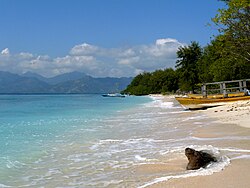
The climate of Equatorial Ostiecia is almost entirely tropical. The uniformly warm waters that make up 81% of Equatorial Ostiecia's area ensure that temperatures on land remain fairly constant, with the coastal plains averaging 28 °C (82 °F), the inland and mountain areas averaging 26 °C (79 °F), and the higher mountain regions, 23 °C (73 °F). Temperature varies little from season to season, and Equatorial Ostiecia experiences relatively little change in the length of daylight hours from one season to the next; the difference between the longest day and the shortest day of the year is only forty-eight minutes. This allows crops to be grown all year round. The main variable of Equatorial Ostiecia's climate is not temperature or air pressure, but rainfall. The area's relative humidity ranges between 70 and 90%. Winds are moderate and generally predictable, with monsoons usually blowing in from the south and east in June through September and from the northwest in December through March. Typhoons and large-scale storms pose little hazard to mariners in Indonesian waters; the major danger comes from swift currents in channels, such as the XX and XX straits. Equatorial Ostiecia experiences a number of climates, mostly tropical rainforest (highest precipitation), followed by tropical monsoon and tropical savanna (lowest precipitation). However, oceanic climates and subtropical highland climates are found in a number of high-altitude regions in Equatorial Ostiecia.
Monsoons

The extreme variations in rainfall are linked with the monsoons. Generally speaking, there is a dry season (April to September), influenced by the Vallos and Sarpedon continental air masses, and a rainy season (October to March) that is caused by Polynesian Sea air masses. Local wind patterns, however, can greatly modify these general wind patterns, especially on the islands. This oscillating annual pattern of wind and rain is related to Equatorial Ostiecia's geographical location as an archipelago between two large continents. In September and May, high pressure over the XX desert moves winds from Cronacontinent toward the northwest. As the winds reach the equator, the world's rotation causes them to veer off their original course in a northeasterly direction toward the Vallos mainland. During January and February, a corresponding low pressure system over Crona causes the pattern to reverse. The result is a monsoon which is augmented by humid breezes from the Polynesian Sea, producing significant amounts of rain throughout many parts of the Capelranco Archipelago.
Prevailing winds

Prevailing wind patterns interact with local topographic conditions to produce significant variations in rainfall throughout the archipelago. In general, the islands of Equatorial Ostiecia experience the most precipitation, since the north- and westward-moving monsoon clouds are heavy with moisture by the time they reach these more distant regions, with rainfall measuring more than 2,000 millimeters (78.7 in) per year. In part, this moisture originates on high mountain peaks that trap damp air. On the other hand, Floredeterra tends to be dry, with some areas experiencing less than 1,000 millimeters (39.4 in) per year.
History
Pre-arrivals
Humans settled Vallos at some time around 12,000 BC according to archaeological evidence, a relatively late date of settlement for most parts of the Occident. The earliest settlers exhibited a relatively similar material culture to contemporary residents of what would become Pelaxia, suggesting a westward migration at that time. The Neolithic revolution occurred on Vallos to a limited extent, as large urban cities did not develop, but farming of local grasses and other flora made settled farm life viable. About forty percent of people in Vallos adopted agricultural lifestyles by 2000 BC. Society continued to develop, with indigenous prehistoric reaching its apex with the shark pottery culture, a material culture so named for the use of both shark teeth and bones as a crafting material in addition to the use of shark-related motifs on pottery. The shark pottery culture reached its peak around 1800 BC, just prior to the arrival of the first Heaven Ships and later arrival of the Polynesians. Archaeologists have uncovered several urban centers of around a thousand people all along the eastern coast of Vallos which were likely fishing centers and the source of shark material. Shark pottery culture continued its existence following the arrivals of foreign culture groups, although archaeologists classify much of it as "late shark pottery" due to the introduction of foreign innovations.
Besides their material culture, virtually nothing is known about the indigenous Vallosi. With limited technological advancement relative to the arrivals and no system of writing, much of "pre-arrival" Vallos was lost within generations of the arrivals of the foreigners. Genetic testing suggests most people in Vallos have less than ten percent DNA from the original indigenous, suggesting near-total displacement by intermarriage and later waves of colonization.
Polynesians
The first Polynesian people likely arrived in Vallos in around 1500 BC. These first arrivals are believed to have sailed the Polynesian Sea from Peratra and other islands along the way which Polynesians had settled earlier. Unlike the earlier indigenous peoples, significant amounts of information have survived in the way of myths and legends. Literary scholars and historians surveyed all Polynesian-descendants in Vallos in 1978 through 1981 to collect all legends and oral traditions, then compiling the most plausible elements known as the "Vallosi Saga." The Saga details the arrival of the Polynesians, finding local agriculture which suited them, and a violent response by the natives once the Polynesians were found picking food in their fields. The first arrivals retreated. At some later point, a large fleet (for its time) of Polynesians came and killed many of the natives living close to the southwestern coast, taking their women as their wives and taking control of their farms. Most historians, even those not involved in the project, accept the Saga as a relatively plausible series of events. Beyond the "first conflict" depicted in the Saga, the presence of a small Polynesian settlement encouraged more arrivals. The relationship between the natives and Polynesians appears to have been mostly characterized by conflict, with significant devastation and demographic displacement occurring. Based on genetics, it appears many refugees - especially women and children - fled north in the wake of the growing series of Polynesian colonies in southern Vallos. By 100 BC, Polynesians made up the vast majority of the population of the southern third of Vallos, but genetic testing suggests that significant intermarriage of indigenous people played a role in the population boom. By this time, Vallos had become the most populous home of Polynesian peoples outside of Peratra.
Heaven Ships
Heaven Ships brought Cronan peoples from the ancient forebears of the North Songun civilization to Vallos at some point prior to 1000 BC, though it's unknown exactly when the first Heaven Ship arrived. Cronan settlement in Vallos likely occurred in series of stops and starts, with individual villages being established one at a time with the arrival of different ships. Based on genetic evidence, it appears likely that intermarriage started almost immediately, such that a sizable population of Cronan-descended peoples lived on the north coast of Vallos by 850 BC. Evidence also suggests that, though Cronan traditions would become dominant due to cultural advancements like writing and other factors, most of the people living in the region prior to the Latin arrival were, genetically, majority indigenous. This fact speaks to the relatively small number of arrivals on the Heaven Ships, and also suggests a very small survival rate. Ships from Crona would continue to intermittently land until around 200 BC, bringing additional Cronan cultural developments and Cronan genes into the north of Vallos. By 500 BC, the first signs of a distinct Tainean culture - Cronan cultures blended together with indigenous influenced introduced - are evident in the archaeoligcal record. Few tribes and indigenous polities remained by this time period, and by 100 BC it appears they were either conquered or integrated within the growing Tainean world.
Adonerii colonization
Latin settlers from the Adonerii arrived relatively late in terms of Vallosi settlement, with the first Latin colonies appearing in modern Porta Bianca in roughly 650 BC. Unlike mainland Sarpedon and Levantia, Vallos was remote from Urlazio and required the development of fully fledged cities in modern Cartadania before regular colonial travel as far west as Vallos was economically and logistically feasible. Nonetheless, the arrival of the Latins heralded the first wave of "true cities", highly organized hierarchical urban areas. The relatively fertile ground of Vallos was an attractive colonial site for the next several centuries, with refugees fleeing political upheavel in Urlazio forming a major wave of settlement in ca 500 BC. At this time, the Latin colonies remained far more urbanized than either the Tainean or Polynesians, allowing smaller but stronger polities to form around an urbanized core on the east coast. By 100 BC, further waves of Latin colonists began to slow, but Latins were firmly established on the eastern part of Vallos facing both the Tainean Sea and Kindreds Sea. Despite this, much of the interior land under the possession of Latin city-states were still farmed and occupied by Tainean people.
First warring states period
The arrival of three separate groups of settlers established an extremely large range of polities throughout Vallos by 1 AD, with Tainean and Latin polities being roughly equal in number and Polynesians ruling the south in larger realms.
Loose Caphiric hegemony
The warring states period necessarily invited outside intervention as the various states tried to court powerful allies on Sarpedon. By 600, the situation drew the attention of the Caphiric First Imperium, still at its relative zenith of power. Diplomats from Caphiria began to arrive on Vallos at ca 600, followed by promises of tribute and alliance between Caphiria and local powers. The First Imperium, contrasted with later Caphirian states, aligned itself equally with disparate Tainean, Latin, and Polynesian states, not showing favoritism necessarily to the Latin city-states. As tribute began to flow east across the Tainean Sea, leaders in Caphiria recognized the potential value of further intervention in Vallos. In 702, Imperator XXX personally led a campaign at the head of roughly 23,000 across the Tainean into Vallos, an unprecedently large military for Vallos. The Imperial army, in support of various local polities, waged a campaign of extreme violence, and due to the size and training of the force it won every battle it fought and could not be opposed by any local power. Rather than directly annex territory, the Imperium reorganized Vallos into eleven tributary states out of the previous dozens of polities and city-states. Critically, the new eleven tributaries did not consider local cultural lines but instead were created on geographic features allowing ease of governance. The so-called "Undecimvirate" established loose Caphiric hegemony over Vallos, though none of it fell under direct Imperial control.
Under the Undecimvirate, rulers were generally hereditary and had the title of King, although each new King required confirmation by the Imperator. All eleven were expected to submit a quarter of their total yearly revenue to Caphiria as tribute, a figure later changed to a flat rate. Tribute was generally determined by an examination of the realm finances by a diplomat from Caphiria, and in most cases the historical record suggests they greatly exaggerated the annual income of the realms to their detriment and Caphiria's benefit. The Kings had no obligation to one another, but were generally discouraged from conquering territory. Raiding between the Kings was still allowed, and once a flat rate tribute was introduced, raiding became an extremely common practice as the Kings fought to ensure timely payments. On more than a dozen occasions, the First Imperium's armies were forced to campaign on Vallos in order to remove a subordinate King who failed to pay tribute or otherwise attempted revolt.
Despite the heavy hand of Caphiric influence and continued raiding, the Undecimvirate established relative stability in Vallos for hundreds of years, only collapsing with the final end of the Second Imperium in 1172. During the more than four hundred years of Caphiric influence, Christianity was introduced to the region and became the primary religion of all eleven realms, though it was far more successful among the Tainean and Latin peoples than in the south, where it achieved plurality status. The Undecimvirate also saw the consolidation of Tainean culture and the blending of Tainean, Latin, and Polynesian cultures in former borderlands, greatly enhancing the cultural diversity of Vallos during this period.
Second warring states period
The collapse of Caphiric hegemony over Vallos in 1172 inaugurated a second chaotic period of warfare that would last for over two hundred years. Centuries of raiding had led to economic deprivation in some quarters of Vallos and significant dynastic hatred between nearly all of the eleven kings. The worst part of the warring states period came during its initial century, which saw five different royal dynasties completely exterminated and most of the eleven kingdoms disintegrate into regional factions.
Kingdom of Oustec
The rise of Occidental oceanic trade presented a number of opportunities for the petty kings of Vallos, especially in the wake of Aster's expedition which introduced trade to Crona from Sarpedon. Centuries of war had created significant hardship and lack of opportunity for additional plunder in the form of tribute, but the increasing volume of trade centered near Vallos by the decade caught the eye of both local authorities as well as enterprising individuals. Beginning in around 1450, petty kings began to sponsor public privateering of trade ships in St. Brendan's Strait. Besides the negative impact on overall trade, the sudden influx of wealth back into Vallos, the piracy produced had a profound impact on its politics. In many different cases, privateers had become significantly wealthier than their local ruler, and they used these funds to take over the port they lived in and eventually neighboring settlements. By 1500, most of the northern third of Vallos had become "piratocracies" - realms created by force by wealthy privateers. These states would transform into efficient machines of piracy, as the state apparatus and military continued to grow in support of piracy. This process grew exponentially as Varshan opened its doors to Vallosi slave traders in 1579, making it so that not only the cargo, but the crew, of captured ships were of high value. As they raided the high seas, the piratocracies also consolidated northern Vallos from more than two dozen petty kingdoms into just three large Kingdoms who actively competed for the right to raid and plunder. The most prominent of these realms was the Kingdom of Oustec, established in the northern archipelago in 1566 by the conquest of one privateer of the outlying insular territories of another. Oustec, the privateer-turned-King, would later unify the northern Capelranco Archipelago and push on to mainland Vallos, with his successors establishing the southern boundary of the Kingdom in modern Arona in 1598. The Kingdom of Oustec would go on to be the primary rival of encroaching Occidental powers for the next centuries.
Initial Levantine intervention
Following the Great Confessional War (1555 - 1575) in southern Levantia, a massive population diaspora occurred. Tens of thousands of Protestant Levantines took to the seas to find new homes free from Catholic persecution, especially with the intensification of the Dragonnades. Many of these refugees were organized under trade companies formed in various principalities the form modern-day Burgundie. But not every trading company was built on the concept of bleeding the fleeing Protestants dry. The Martillien North Levantine Trading Company (MNLC) was chartered in 1579, under the newly ordained Catholic Duchy of Martilles "to control the trading interests of Martillien merchants from the borders north of the upper reaches of the Kingdom of Dericania unto the lands at the zenith of the His terrestrial orb (read Kiravia)". Conspicuously absent were longitudinal limits on the charter.
Following reports of successful settlements in Altaic Sea basin the Martillien North Levantine Trading Company (MNLC) dispatched Jean-Claude Gastineau and a small fleet to establish a Catholic trading post in the area. Arriving in the Alstinian Isles in late 1591, they wintered in the wilderness far from the predominantly Protestant settlements. Cold, disease, and Protestant raids reduced the part from 153 men and 14 ships to 73 men and 6 ships. In the early spring, they made out for mainland Crona to find a suitable and secluded spot to establish a Catholic factory. After 4 months of surveying the coast, a number of suitable locations were noted. Gastineau returned to the Duke of the Martilles and the investors of the Martillien North Levantine Trading Company (MNLC) and presented them with his findings. The Archbishop of Martilles was more interested in the Protestant settlements in the Alstinian Isles and the decision of where to settle a trading post was shelved while Gastineau and his lieutenants drafted a report on military strength, fortifications, indigenous conversion efforts, and infrastructure developments. He became very frustrated with the delay and appealed to leave some lieutenants behind to finalize the report after he had departed to start the return journey. He was denied during each appeal. Ultimately, the report was completed after 6 months of writing and redrafting. After the Archbishop accepted the report, the Duke and the investors met again to pick a settlement spot. They made their selection and outfitted Gastineau with a contingent of 183 men (outfitted with the finest military materiel available in the Duchy), 16 ships, animals, and 5 priests. They arrived in the fall of 1593, establishing the factory of Port-Verde (present-day Gastineau).
In the following years trading between Port-Verde and Martilles increased and immigrants started to arrive in greater numbers as the vast "untapped" wealth of Crona became legendary in the coastal states of the Kingdom of Dericania. However, the piracy that plagued St. Brendan's Strait threatened to terminate the potential of the colonial endeavor. Something had to be done and the Duchy of Bourgondii sought to exploit the situation and force Martilles to pay them protection. The Bourgondii Royal Trading Company was commissioned to establish a port in the islands of Vallos and with a fleet built by the Duke of Bourgonii (subsidized by both the Holy Levantine Empire and the Papacy), their remit was to charge a convoying fee and clear the path for Occidental traders making their way to Crona. They were further authorized to make settlements as they saw fit in Vallos. The lands of the northern archipelago and northern third were targeted, beginning centuries of conflict between the Bergendii and the Kingdom of Oustec. The fleet of 12 older carracks, 3 fluytes, and 5 of the newly designed and faster frigates set out in 1597. These ships reached Catavis in early 1598 and established a small outpost. In the summer they had refitted and set out in search of pirates. The fleet met mixed results that summer, capturing three Oustec pirate galleys but losing two carracks. The men they had brought were sailors, not rowers so the galleys were not immediately usable. That winter they brought 500 slaves from the Bourgondii Royal Trading Company's Istroya Oriental colony to serve as galley slaves, a further 215 slaves to work iron mines to establish a cannon foundry that would be led by a cannon manufacturer from the days of the Oduniyyad Caliphate. They also brought 184 colonists who established Portilles a small port town on Catavis.
In the spring and summer of 1599 they were much more successful and carried 17 convoys safely through the St. Brendan's Strait. Portilles was becoming a more important town as it was where Occidental sailors would have to stop to hire the Bourgondii Royal Trading Company. Its port facilities started to expand as a result and its population grew as some colonists and traders decided to stay. As the Burgoignesc fleet prepared to winter in November they were attacked by a coalition of the pirate kings and Portilles was razed. Many of the ships of the Company were destroyed or captured. In 1600 the Bergendii returned with an army of 7,000, a colonial force of 450, 3,500 Audonian slaves, and a fleet of 100 ships. Portilles was rebuilt, and the first order of business was to change the composition of the fleet. A group of 24 shipwrights were set to survey the forests for usable wood and to construct from it a specific ship to combat the Oustec pirates. The cumbersome fleet survived 1601 while the shipwrights set about their task. In 1602 they decided a patache. Another 240 colonists were brought in to work on the ships along with the slaves. Some of the older carracks were disassembled and tropical timbers were harvested and a fleet of 18 patache were completed for the summer of 1602. These swift, shallow draft boats were able to chase the pirates anywhere and maneuver as deftly between the islands. By 1613, the Bergendii were becoming masters of the St. Brendan's Strait, giving them a sizable base to interdict against Oustec piracy. They began colonizing the islands and taking the fight to the landed nobles of northern Vallos, capturing Port de Vanse in its entirety from the Oustec by 1621. Despite these early successes, the Oustec remained formidable and resisted an effort to invade modern Pescanice in 1629, and after this successful defense Oustec began to rapidly adapt to Occidental military technologies and tactics, remaining competitive for the next century.
Equatorial Ostiecia Colony
Late modern period
As the Burgoignesc Colonial Empire collapsed in the early 1800s a massive influx of Bergendii colonists from Alshar and Audonia sought refuge. As they had been dismissed from Levantine for being Protestant in the first place, they were not welcomed back to the Burgoignesc Metropole.
They were rerouted, en masse to Equatorial Ostiecia were the population exploded from about 27,000 Occidentals in 1800 to about 450,000 by the 1850s. The colony saw an explosive period of urbanization and industrialization of farming to accommodate the seemingly endless tidal wave of people.
Because this was occurring during the industrial revolution there was period during the First Fratricide where Equatorial Ostiecia was more advanced than the Burgoignesc Metropole. Because the colony wants bound up in medieval infrastructure and political baggage it was able to adopt new ideas and technologies immediately.
This is also the period when the primacy of property rights, self-reliance, embracing innovation, and a frontier mentality took hold in Equatorial Ostiecia that still permeates it's culture today. The concepts of Equitorioise ingenuity and Equitorioise stoicism were born of this period.
Odurian War
Main article: Odurian War The Odurian War was a conflict in Vallos that led to the final partition of the Kingdom of Oustec. The war began ostensibly as an intervention into Oustec by Caphiria to protect the community of Latin-speaking cities there. The unification of Burgundie created it as a strong, Levantine colonial power with extensive possessions bordering Oustec. Its presence sparked a period of fear and panic in Caphiria regarding Levantine Creep and the fate of the Latins in the country. The sudden invasion of eastern Oustec on 18 March 1858 prompted a counter-invasion of the rest of the country by Burgundie in July, fearing that Caphiria might annex the entire rump Kingdom. In August, the estranged Harounan Province declared independence from the crumbling Oustec state and sought protection from Urcea, whose forces in New Archduchy were well positioned to arrive at the Harounan Province in a timely manner. The Oustec, unable to resist invasion from three sides, pulled most of their forces back to their inland capital city of Oduria. Oduria was besieged by Burgoignesc forces for much of 1859 before finally falling towards the end of the year. The conflict threatened to escalate into a general conflict involving the three Occidental powers before Kiravia brokered a peace.
Contemporary period
Second Great War
Invasion of Vespera
Operation Kipling
The wars of Operation Kipling formed the modern Equatorial Ostiecia. It was used as a forward operating base for the various general staffs and as a forward manufacturing and logistical hub. The logistical infrastructure that criss-crosses the country were laid down or expanded during the course of the wars in Alshar and Audonia. It is also why most of the infrastructure favors the western sides of the islands. The raw materials coming from the Burgoignesc Metropole were smaller and easier to disembark in the older ports and rail hubs in the eastern shores of Equatorial Ostiecia. As the products were assembled they became larger and more complex and by the time they were completed and ready to send to the war zones they required larger and more complex logistical chains. This has led to more rail and shipyards in the western portions of the country and more airfields as well.
1980s through today
After the conclusion of Operation Kipling the Security Forces of Burgundie sold off much of the manufacturing and logistical assets it had built/subsidized to private firms who were immediately take ownership and turn a profit. This lead to a huge economic boom that lasted from about 1987-1995. It waned with the advent of the global adaptation of the internet but a few companies were forward thinking and invested heavily in the adoption of the new technology. The shipping company wars of the mid 90s ravaged large swathes of the economy to the point were the national government of Burgundie stepped in and mediated a peace and what had once been a patchwork of 100s of smaller owner/operator logistical concerns was reduced down to three large logistical companies to provide stability, maintain competition, and standardize the infrastructure to international standards.
This infrastructure standardization led to a construction and network system development boom that led the economy for approximately 15 years from 1998-2013. While construction and infrastructure maintenance is still a strong aspect of the economy, it is a mere shadow of itself in the early 2000s. Bringing all of the micro systems online or into a centralized corporate database meant that an entire sector needed to be stood up overnight. This also means that government-owned internet infrastructure was pervasive across all of Equatorial Ostiecia with fiber optic internet being standard and 4 and 5G towers covering 97% of the countries population.
Equatorial Ostiecia also was the first Levantia and Odoneru Treaty Association (LOTA) constituent to thaw relations with Caphiria and as such had virtually zero competition in the trade to and from Caphirian markets to consumers in LOTA countries. It also saw a rapid growth in the tourism sector as Caphirian tourists and tourists from LOTA nations would come and gawk at each other on "neutral" ground. Tourism has since subsided but it is still a popular destination for Yonderrians who want to get a sun burn without having to learn another language.
Companies in Equatorial Ostiecia used this revenue to expand their markets to nations on all continents and to diversify their internal economy as well.
Politics and government
Faramount is a constituent country of Burgundie with its own assembly, prime minister, budget, and laws. Burgundie's national governmental influence is limited to subsidies, education, and security, however, its financial and cultural institutes cast a long shadow across Faramount.
Faramounteuers are Burgoigniacs/Burgoignix with complete civil and economic rights, and citizenship (political rights) under the same federal service criteria as all residents of Burgundie. Burgoignesc is the official language.
Administrative divisions
Equatorial Ostiecia is divided into five provinces. They are:
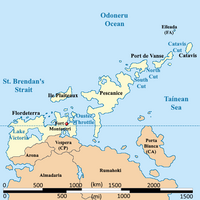
| Name | Capital | Population | Area in km2 | Population density in km2 |
|---|---|---|---|---|
| Catavis | TBD | 915,936 | 6164.171 | 148.59 |
| Flordeterra | Drovan | 35,088,050 | 224526.069 | 156.28 |
| Ile Plaiteaux | TBD | 2,346,457 | 21755.900 | 107.85 |
| Pescanice | TBD | 15,546,680 | 173736.402 | 89.48 |
| Port de Vanse | TBD | 4,858,164 | 34679.940 | 140.09 |
Flordeterra
The "mainland" province of Equatorial Ostiecia and its immediate surrounding islands is Flordeterra, its capital is Vilalbanes. It is the capital province of the country, with the federal government capitaled at Fort Monteneri.
Cities and towns
- Binau
- Bergemiers
- Bergevers
- Vitrobagne
- Nanlet
- Antotoise
- Toulun
- Belcourt
- Marmasse
- Orsart
Fort Monteneri
Capital of Equatorial Ostiecia
Pescanice
The largest island province is called Pescanice, its capital is Port de Vent.
Cities and towns
- Bougnane
- Cammont
- Vabonne
- Perippes
- Baseau
- Carcaleme
- Borves
- Dissonne
- Touroux
- Nanmiers
Major businesses
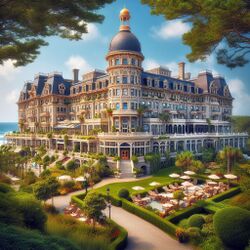
Ile Plaiteaux
Ile Plaiteaux is the island province due north of Flordeterra, its capital is Portinhes.
Cities and towns
- Martiluson
- Auberville
- Perpinoit
- Roassion
- Aubertou
- Montaugnan
- Vitromiers
- Vagnie
Port de Vanse
Port de Vanse is a cluster of islands northeast of Pescanice, its capital is Aprolpheia.
Cities and towns
- Poilly
- Lillon
- Houttien
- Aurifort
- Marris
- Vilden
- Gosart
- Colciennes
Catavis
The smallest province to the extreme north east is Catavis, its capital is Portilles.
Cities and towns
- Angougnan
- Montauvin
- Haguerault
- Damiand
- Nanles
- Babagne
- Haguelliers
- Besanlon
Law enforcement
Military installations
Equatorial Ostiecia is home to many military bases, Fort LaRemie, operated by and headquarters to the Foreign Legion, is the largest and most prominent.
Fort LaRemie
| Fort LaRemie Foreign Legion Command, | |
|---|---|
| | |
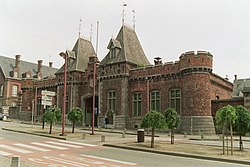 Main entrance to Fort LaRemie | |
| Site information | |
| Owner | Burgoignesc Security Forces |
| Operator | Army of Burgundie |
| Controlled by | Burgoignesc Central Combined Forces Command, Equitorial Ostiecoise Sector |
| Condition | Operational |
| Site history | |
| Built | 1884 |
| Garrison information | |
| Occupants | Foreign Legion
|
The military installation now know as Fort LaRemie was first established as a militia training camp in the 1600s under orders of the Bourgondii Royal Trading Company and used as a mustering ground for over 150 years. It was also a town common for grazing animals when not serving its military purpose. In the 1780s its militia use was discontinued. The grounds were eventually sold to a private land owner.
| Joint Naval Station Daniel Launtceur | |
|---|---|
| Near Port Clasier in | |
 Joint Naval Station Daniel Launtceur, upon completion in 2034. | |
| Site information | |
| Owner | Burgoignesc Security Forces |
| Condition | Operational |
| Site history | |
| Built | 2024-2029, 2033-present |
JNS Daniel Launtceur was named for the Burgoignesc naval officer who assisted with the creation of much of Arcerion's modern surface warfare doctrine, rooted in the Second Great War. His participation in the drafting, acceptance, and implementation was only second to his role as one of the combat officers on His Majesty's Arcerion Ship Tusk, a light cruiser that conducted surface raids and actions against Capetian vessels during the Second Great War. To date Daniel Launtceur is the only non-Arcer officer to receive the Arcerion Order of Merit (AOM) for wartime actions with the Royal Arcerion Naval Service.
The base was originally built during the Bourgondii-Loa Wars as a minor retrofitting station in 1837. At the conclusion of that conflict the station was all but abandoned but, its ownership remained in the hands of the Navy of Burgundie. In the First Great War it was reactivated, but its facilities were too archaic for it to be useful, so it served primarily as a barracks and training ground for local militias. After the conclusion of the First Great War it was loaned to the Revenue Guard as a Lifesaving Station. It served in that role until the Second Great War when a massive construction effort was made to allow for deeper draft ships to dock. New piers were constructed and modern radio relays were installed. These improvements were the last major reconstruction of the base until it was retrofitted for the Arcerion's in 2024-2029. Many of the smaller berths were back-filled to allow for easier replenishment of larger ships and for the dredging of fewer, deeper channels. New radars, and datalinks were installed as well as demolishing all of the facilities on the base and building them to a modern standard. The work was conducted by O'Shea Infrastructure and Design and many of the materials used were purchased from Estia-Odoneru Gypsum, Salt, and Aggregate.
As part of the the [[2033 Arcer Armed_] Forces Act]] the base is under construction, increasing its largest berth to accommodate the Kurst aircraft carrier group, as well as a host of replenishment vessels, merchant marine expeditionary support ships, and maritime aircraft such as helicopters and transports. This
Culture
The tenants of Mercantile Reform Protestantism predicate almost all aspects of culture in Equatorial Ostiecia. Work ethic, attire, observation of life's milestones, and entertainment are all conducted in a manner consistent with the modern practice ofMercantile Reform Protestantism. While not as stuffy and puritanical as it was in the past, society in Equatorial Ostiecia is the most formal, modest, and bound in societal norms of all of the constituent countries of Burgundie.
Work ethic
Attire
Because of the climate, the standard fabrics for clothing in Equatorial Ostiecia are linen and muslin. These fabrics are either left in their natural colors or bleached white. Because of the predominantly Mercantile Reform Protestant attire is Occidental, but notably formal and modest. In a professional environment men's shirts are typically button downs either with a turnover collar with some form of neckwear, or a Nehru collar without. High-waisted, pleated trousers are also common, without a cuff. Sleeves cut at the wrist and are worn slightly billowy for ventilation. In divergence from common Occidental styling, on top of these clothes is typically worn a kandora, an ankle-length robe, usually with long sleeves. This is a tradition brought from Bergendii fleeing the collapse of the Burgoignesc Colonial Empire in Audonia and Alshar in the early 19th century and its name is both the name of the garment in Chaukhiran Arabic and after the colony of Kandara. In non-professional settings men typically wear camp shirts and linen trousers. Shorts are frowned upon for grown men. Women typically wear linen dresses, but modest blouses and slacks are acceptable. Over this, women typically wear a richly embroidered thawb, with different colors and patterns signifying various aspects of the wearer's social position and it's unique from town or city to another.
Dance
Death
Sport
Film
Religion
Equatorial Ostiecia is predominantly Mercantile Reform Protestant. The country upholds religious freedoms and there is a diversity of religions and other Christian Rites making up 34% of the population.
Cuisine
Education
Economy
Employment
Agriculture
Tourism
Agrinergie
Main article: Agrivoltaics
Logging/Mineral extraction
Lignum vitae and Mahogany tree plantations for daaaaaaaaaays!
Paper milling
Mining
Drilling
Fishing
Aquaculture
Main article: Aquaculture
Pisciculture
Main article: Pisciculture
Mariculture
Main article: Mariculture
Trade
Transshipment
Main article: Transshipment
Customs and tariffs
Main article: Customs
Infrastructure
Maritime
Lighthouses
Roads and rail
Air
Energy and electricity
Phone service and internet
Demographics
Language
Burgoignesc language Reform Tainean



